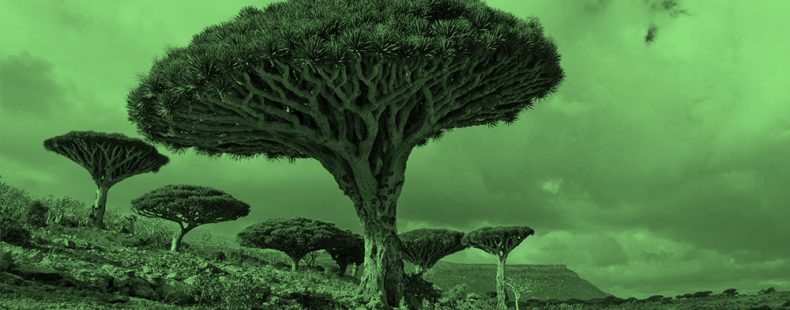There are a lot of reasons to love trees. They provide us with shade, fruit, beautiful flowers, and clean air. In addition to all of these perks, many of them also have fascinating names. Trees take their names from famous people in history, stories in mythology, and even the special extracts and resins they produce. Some of them are hundreds of feet tall. Others have rainbow bark—yes, really! Here are 15 different trees from all over the world whose unique name origins will fascinate and amuse you.
1. banyan
East Indian fig trees are also known as banyan trees. Banyan is a historical name once given to merchants and traders in India. In the late 1500s, Europeans began applying this name to the species of tree near which some of these merchants had built booths. Banyans are recognizable for their widespread branches and complex root systems.
2. sequoia
Many of the giant, coastal trees in Northern California are called sequoias. They can grow to be hundreds of feet tall, and they take their names from Sequoya, a Cherokee chief and scholar credited with creating the 86-symbol phonetic alphabet for the Cherokee language. The name sequoia was first applied to the trees in 1847 by a German botanist named Stephen Endlicher.
3. baobab
Baobab trees are native to the African continent and bear a gourd-like fruit that reveals how they got their unique name. Baobab is a translation of the term bahobab, which was first cited in a description of the tree’s fruit by the Italian physician and botanist Prospero Alpini. The true origin of the word is obscure, but it likely has roots in early Central African languages.
4. hop hornbeam
The hop in hop hornbeam is a reference to the hop-like fruit the tree bears, but you might be wondering: what the heck is a hornbeam? It refers to the tree’s heavy wood. A hop hornbeam is a type of birch tree, and the wood from its European counterpart was typically used to yoke oxen. Because it was sturdy and thick, the wood served as a “beam” to yoke “horned” beasts of burden. Of course, some kept it more simple and called this tree ironwood.
5. loblolly pine
Like many trees, the loblolly pine was named for the places where it originates. Then, what is a loblolly, you ask? Throughout parts of the Southern US, loblolly is a term for “mudhole.” These tall pine trees typically grow in wet, swampy areas, and their name is a reference to the places where you are most likely to find them.
6. witch hazel
Witch hazel might make you think of spooky potions, but the name of this yellow-flowered tree actually isn’t related to witches. The witch in witch hazel may actually come from the Old English wice, a term that means “pliant” and was applied to various plants and trees with bendable branches. One thing about this plant that does seem like magic is the medicinal liquid extracted from its leaves and bark, which can be used as a liniment for inflammations and bruises and as an astringent.
7. monkey puzzle
The monkey puzzle tree is another name for the Chile pine, a South American, coniferous timber tree with candelabra-like branches and stiff, sharp leaves. Its odd nickname dates back to the mid-1800s and is actually more self-explanatory than you might think: they’re called monkey puzzle trees because the intertwined arrangement of their limbs and sharp needles make them appear difficult to climb.
8. dragon’s blood
Dragon’s blood trees may sound intimidating, but dragon’s blood is actually a nickname for a rattan palm tree native to the tropical and subtropical climates of southeast Asia. These trees are known for the unique umbrella shape of their canopies and named for their resin, which appears dark red in color and has several medicinal uses.
9. horse chestnut
Horse chestnut trees have small white, pink, and red flowers in the spring and are common throughout the US. They also grow brown, shiny nuts, which is how they get their unique name. Horse chestnut is a translation of the New Latin term castanea equīna, which is named for its use in treating respiratory diseases in horses. These nuts are actually poisonous if consumed by humans.
10. rainbow eucalyptus
Rainbow trees? Yes, they’re real. The Rainbow eucalyptus is a type of eucalyptus tree native to the Philippines, Indonesia, Papua New Guinea, and parts of the Southern US. They get their name from their bark, which grows in shades of green, blue, orange, red, and purple. Eucalyptus comes from the Greek kalyptós, meaning “covered, wrapped.” As the tree grows, the bark peels off in strips to reveal new colors and patterns underneath.
11. rowan
The European mountain ash by any other name might be called a rowan tree. The name Rowan comes from Norse mythology, in which these trees are featured prominently. The ancient Norse people believed the first woman was created from a rowan tree. Norse mythology also featured rowan trees in a story about the Norse god Thor. According to the legend, rowan trees once saved Thor’s life by bending over a fast-flowing river to help him escape the Underworld.
12. magnolia
Magnolia trees grow throughout North America, and they’re known for their stunning white and pink flowers. But the name of this tree and its flowers was actually inspired by a person. The magnolia was named for Pierre Magnol, a French botanist who is credited with creating the first classifications of different plant families.
13. Ponderosa pine
You might know the Ponderosa pine as the state tree of Montana. It’s a large Western yellow pine, but its unique name has a surprisingly simple explanation. The tree’s scientific name is pinus Ponderosa. Translated from New Latin, it literally means “heavy pine.”
14. Nyssa
The Nyssa tree is native to Missouri, though its name comes from somewhere else. Nyssa, or Nysa, is one of the Nysaean water nymphs in Greek mythology. She came from the mountainous region of the same name, where the God Zeus sent his infant son, Dionysus, to try to protect him from the wrath of Hera. The Nyssa tree is found in low, wet wooded areas, hence its name’s association with water.
Take our quiz
Don’t leaf! We’ve got yet one more task for you: a quiz. Ready to be tested on these name origins? (We promise no geo-me-tree, just words.)














